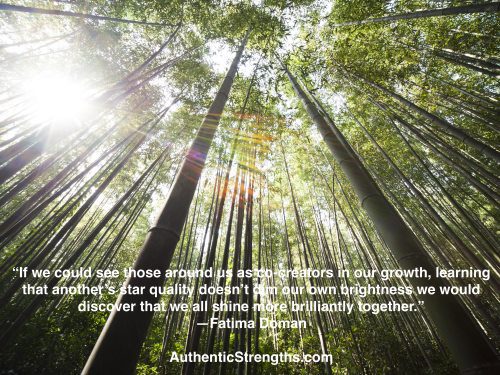The original meaning of the verb “to compete” is “competere,” which means “to strive together.” Today, however, many of us think of competition in terms of rivals and contention.
Photographer Kevin Garrett suffered a brain injury when his car was struck from the rear on his way to a photo shoot. David Johnson, a competing photographer, learned about the accident and that Garrett was having difficulties. He cleared his schedule and flew from his studio in New York to help Garrett learn how to use some new equipment.
Calling forth our character strengths when surrounded by colleagues who have traded in character for winning at all costs can require courage. Professional photography is known to be a cutthroat business and, over the years, Johnson and Garrett have gone on to compete directly for jobs at times. They’ve astonished some of their clients by recommending each other for jobs, loaning each other equipment, and sharing names of crew members in a business where people jealously guard every aspect of their business.
If we could see tho
se around us as co-creators in our growth, learning that another’s star quality doesn’t dim our own brightness, we might learn that we can all shine more brilliantly. Great leaders are at heart high achievers who see themselves as resources rather than competitors. It’s no wonder this photo inspired millions: Meghan Vogel, right, helping competitor Arden McMath to the finish line after McMath collapsed yards short in the 3200 meter finals. In an era of unprincipled competition and negative news, we are all hungry for examples of character in competition.Learning to appreciate character strengths does not diminish self or others, but rather builds people, teams, and organizations. When we strive to develop what is best in ourselves, others will catch the vision and want to do the same. In fact, renowned positive psychologists, Seligman and Peterson described the social impact of character strengths as follows:“In many if not most cases, onlookers are elevated by their observation of virtuous action. Admiration is created more than jealousy because character strengths are the sorts of characteristics to which most can–and do–aspire. The more people surrounding us who are kind, or creative, or full of hope, the greater our own likelihood of acting in these ways. Said another way, strengths accompany non-zero-sum games (Wright, 1999). All are winners when someone acts in accordance with his or her strengths…”
Character strengths are the most important aspect of ourselves that we want recognized and understood by others. They are collectively responsible for our greatest achievements and fulfillment. Positive psychologists have identified twenty-four of these strengths–the basic building blocks that represent our individuality, psychologically speaking. We each possess all twenty-four in varying degrees and combinations. These strengths are universally valued around the world and scientists define them as positive traits that are beneficial to self and others. They lead us to positive emotions, relationships, and into engaging and meaningful activities where we flourish–at work and in life.
The tide is changing. Greedy, aggressive behavior is quickly exposed these days. Successful leaders know that character is where the edge is–encouraging their people to put their authentic strengths to work to build a better whole.
References:
Peterson, Christopher, and Martin Seligman. Character Strengths and Virtues: A Handbook and Classification. American Psychological Association, 2004.
Photo of two competitors that inspired millions taken by the Piqua Daily Call photographer Mike Ullery.


